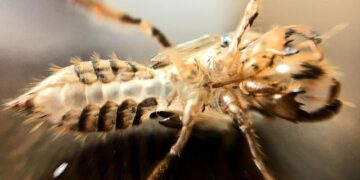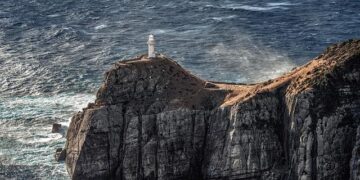In the age of air travel, the Calanais Standing Stones (or Callanish, in the anglicized spelling) are not so hard to get to, and yet, the site feels remote.
The ancient stone megaliths are perched at the edge of the village that shares their name, on the west coast of the Isle of Lewis, part of the Outer Hebrides chain of islands that sits off the northwestern coast of Scotland. Having read of Calanais’ status as the “Stonehenge of the North,” I was determined to make the journey; it had been on my bucket list for years.
Stonehenge itself tends to unfairly dominate conversations about prehistoric Britain. Yes, it is the most visited stone circle, and certainly one of the most striking, but it is hardly alone. Many hundreds of ancient stone circles still exist across Britain and Ireland, along with other prehistoric structures like long barrows (elongated burial mounds), passage tombs (burial chambers with narrow entrance passages), and solitary standing stones.
These enigmatic sites carry the visitor back to a time when writing and metal tools were unknown, farming was a still novel idea, and stone monuments established a community’s presence on the landscape. That presence continues to captivate us today — whether it’s Calanais, equally compelling sites further north in the Orkney archipelago, or other Neolithic landmarks.
Constructed from local rock, the Calanais stones contain minerals that sparkle in the sunlight. (Credit: Phil Silverman/shutterstock)
Bringing a Culture
From Stornoway, the only town of any size on Lewis, a half-hour bus ride brings me to the village of Calanais — a smattering of small farms, known as crofts — just north of the monument.
Arriving at the stones, some 49 in all, I was immediately struck by major differences between this site and Stonehenge: For starters, I could just walk in. (A fence borders the site, but only to keep sheep out.) Crowds are rare; on a Saturday afternoon in April, I had the place to myself.
And I could touch the stones, exploring their cold, rough, lichen-covered surfaces. The larger stones range from 7 to 12 feet tall, while the enormous monolith at the center soars to a commanding 15 feet 9 inches. Unlike Stonehenge, where many of the stones were quarried more than 100 miles away, the stones at Calanais are local gneiss, an ancient metamorphic rock that forms the backbone of the Hebrides. With their distinctive bands and sporadic veins of quartz and feldspar, the stones sparkle whenever sunlight strikes them.
Aerial photos show that the innermost stones form a rough circle, about 40 feet across, centered around the tall monolith, with the remains of a small cairn, or chambered tomb, a few feet away. Radiating away from the circle are rows of stones that reach to the west, south, and east, while an extended double row stretches even further to the north, creating a kind of avenue leading into the center. The overall shape is crosslike, running some 300 feet along its long axis, and roughly aligned with the four cardinal directions — a layout unique among Britain’s stone monuments. Viewed from a distance, the stones resemble a line of people. It’s no wonder they earned the Gaelic nickname Fir Bhreig (“the false men”).
The oldest part of Calanais is thought to be its circle; radiocarbon dating puts its construction at around 2900 B.C.E. We know very little about the region’s first inhabitants, though there’s evidence of human activity here for several thousand years before newcomers arrived in the fourth millennium B.C.E., bringing a culture described by archaeologists as Neolithic, or New Stone Age. They raised sheep and cattle, grew crops, fished, and lived in more permanent settlements. These immigrant farmers likely mixed with the Indigenous hunter-gatherer population. Then, a few centuries later — in the early third millennium B.C.E. — they began to erect large, monumental stone structures.
There’s a broad consensus that sites like Calanais were venues for community gatherings, places for ritual and celebration. Because their builders were farmers whose livelihood required tracking the seasons, it’s possible that such monuments had a calendrical function. Stonehenge does, with its central axis aligned with the spot where the sun rises on the summer solstice. A few other Neolithic sites have similar solar alignments.
The builders of Calanais, however, may have been more concerned with the moon than the sun. At the latitude of Calanais, the full moon takes a very low path across the southern sky, particularly in summer. Roughly every 19 years, when the moon reaches its maximum southerly position, it appears to just barely skim the southern horizon. As the moon shines through dips in the nearby hillock, its light streams into the central circle and down the length of the avenue. With the moon close to the horizon, it would also appear peculiarly large — a mesmerizing sight.
The Ring of Brodgar stands dramatically on a peninsula between two lakes and may have been built as a reflection of the larger landscape. (Credit: RnDmS/iStock VIA Getty Images)
Copycat Monuments
One can only imagine the labor needed to erect the largest of Calanais’ standing stones, some of which weigh up to 5 tons. Archaeologists believe workers dug pits (or “sockets”) a few feet deep, then tipped the stones in, using ropes and sheer muscle-power to get them vertical. The final step was to fill the space between the stones and the earth with lots of smaller stones. It was, to be sure, a group effort.
“We’re not talking about not just one family; it’s going to be all of the families in the area,” says Alison Sheridan, a research associate at National Museums Scotland, who also sits on the Board of Directors of Urras nan Tursachan (Standing Stones Trust), the charity that runs the Calanais Visitor Centre. The erection of Calanais also seems to have sparked smaller, copycat monuments in the area. “What’s so interesting is that other people in the area thought, ‘Oh, this is absolutely brilliant,’ and they built their own stone circles elsewhere, in the vicinity.”
But the Calanais builders may themselves have been copycats: The Stones of Stenness in Orkney may be one of the oldest henge monuments in all of Britain. Radiocarbon dating suggests that work began at the site by 3100 B.C.E. The handful of extant upright stones are thought to be the remains of a circle about 100 feet across, consisting of a dozen stones, dating from around 3000 B.C.E.
Sheridan points to the distinctive pottery, known formally as Grooved Ware, found at Calanais. Similar pottery has been found at sites in Orkney, where this pottery style is thought to have originated. Sheridan believes the builders of Calanais were skilled navigators, in close contact with surrounding communities. Traveling to Orkney, they took special notice of the Stones of Stenness, then arranged in a full circle. “Whoever was privileged enough to get into a boat and sail the six-day journey up to Orkney, from Lewis — they will have been really wowed by what they saw there,” Sheridan says. “I’m convinced that Callanish was inspired by the Stones of Stenness.”
A 2019 geophysical survey points to another possible source of inspiration for Calanais’ builders: lightning. A team led by Richard Bates of the University of St. Andrews turned up distinct magnetic signatures consistent with a powerful lightning strike at a spot known as Site XI, a bit less than 2 miles from the main Calanais monument. Today, only one stone remains erect at Site XI, but toppled stones and the sockets where they once stood suggest it used to be a full circle.
“Was it an amazing lightning strike that was then memorialized by building a stone circle around it?” wonders Sheridan. “Or was there a stone circle, and then, my goodness, right in the center of it, lightning struck?” Either way, she says, Site XI and Calanais may have come to be associated with the supernatural. If Neolithic farmers witnessed a powerful lightning strike in their vicinity, says Sheridan, “that is going to be a sign from the gods.”
(Credit: juriskraulis/iStock VIA Getty Images)
Steeped in Symbolism
Besides the Stones of Stenness, Orkney is packed with evidence of Neolithic human activity, from the mighty Ring of Brodgar to Skara Brae, the best-preserved Neolithic village in northern Europe.
Brodgar is almost perfectly circular, spanning some 300 feet. Dating from around 2500 B.C.E., it is the largest stone circle in Scotland; even digging the surrounding stone-cut ditch is thought to have required some 80,000 hours of work. (Stonehenge, which required lifting horizontal lintels to their positions atop upright stones, likely required 30 million person-hours.) The Ring of Brodgar is believed to have once boasted 60 stones, of which 13 still stand. (Another eight were restored to their upright position in the early 20th century.) The stones range from 7 to 14 feet in height and are composed of flagstone and sandstone, both types of sedimentary rock.
The ring’s location is itself dramatic: It stands on a narrow peninsula that separates two lakes, the Loch of Harray and the Loch of Stenness. Archaeologists have speculated that Brodgar’s architecture may intentionally reflect the larger landscape. When it was first dug, the circular ditch was waterlogged for much of the year, which could represent the lochs that surround the site. Whatever inspired the specific architecture, it seems likely that monuments like the Ring of Brodgar were steeped in symbolism for the people who built them.
“People are trying to understand how to reconcile their own brief lives to something bigger, something more persistent,” says Mark Edmonds, an archaeologist and author of Orcadia: Land, Sea and Stone in Neolithic Orkney. “It might be a sense of genealogy, what family lines you’re descended from. It might also be how you think about how you belong to particular parts of the landscape, particular places.”
An association between monuments like Brodgar and the spirits of departed ancestors is very plausible. This is surely the case at Stonehenge, which functioned, in its early years, as one of the largest Neolithic cremation cemeteries known in Britain. At Calanais, human remains have been found in the central cairn, along with bits of pottery that may indicate cleared-out burials.
The fact that Stenness is no longer a grand stone circle highlights a misconception about the use of these monuments, says Edmonds. “It’s very easy to make the false assumption that when people built these places, they built them to last,” he says. “I think a lot of the monuments that we see were built for a particular occasion; they were used for a short period of time, and then abandoned, or just left to their own devices — only for people to then come back and reuse them.” Eventually, many were left to the elements. Calanais, for example, was abandoned — no one knows why — by around 1000 B.C.E.
Perhaps the clearest glimpse into the lives of these Neolithic stonemasons can be found at Skara Brae, on the northwest shore of Orkney’s largest island, where the visitor can gaze at Stone Age homes and workshops, complete with finely crafted walls, hearths, beds, and shelving units. There are also small closetlike cells which may have been used for storage — though one of them, apparently connected to a drainage ditch, might be Britain’s oldest known indoor toilet.
The site may have been settled as early as 2900 B.C.E. After that, there were centuries of continuous use, interrupted by long periods in which Skara Brae lay deserted. The village is believed to have been abandoned for good by about 2500 B.C.E. Eventually the site became covered in sand; it was only rediscovered in 1850, when a violent storm revealed portions of the ancient structures.
Skara Brae is one of the best-preserved Neolithic villages in northern Europe. (Credit: Flavio Vallenari/iStock VIA Getty Images)
Unearthing New Discoveries
There’s more: Close to Stenness is Maeshowe, a Neolithic cairn and passage grave. In 1999, these four sites — the Ring of Brodgar, Stenness, Skara Brae, and Maeshowe — were declared a UNESCO World Heritage Site, known collectively as the “Heart of Neolithic Orkney.”
An ongoing archaeological dig at yet another site, a collection of Neolithic buildings called the Ness of Brodgar, located between the Ring of Brodgar and the Stones of Stenness, has been unearthing new discoveries regularly for the past two decades.
“Some of the discoveries have just been jaw-dropping,” says Nick Card, the site’s director. The Ness has yielded tens of thousands of artifacts, from pottery and cooking utensils to an intricately carved ball, the size of a softball, whose purpose is a mystery. Just as fascinating is the warrenlike den of Neolithic buildings in which the artifacts were found. The walls were so carefully built that in some places you’d struggle to wedge a playing card between the stones. “If you discovered one of these structures in your lifetime, that would be amazing,” Card says. Amazingly, his team has uncovered 39 of them “and there’s many, many more still waiting to be discovered in the areas that haven’t been excavated.”
But 2024 will be the last year that Card and his team will be working here — in part because of the cost of keeping such a large project going but also because they’ve already found so much more than they’d imagined. The shelves in Card’s offices are already jammed floor to ceiling with boxes of artifacts excavated by his team. Like the mysterious sites they came from, these discoveries will require a lifetime, and then some, to study.
This story was originally published in our May June 2024 issue. Click here to subscribe to read more stories like this one.0
>>> Read full article>>>
Copyright for syndicated content belongs to the linked Source : Discover Magazine – https://www.discovermagazine.com/planet-earth/finding-monuments-beyond-stonehenge































